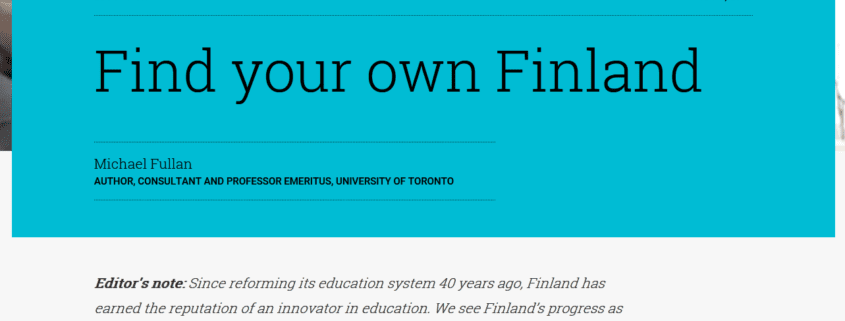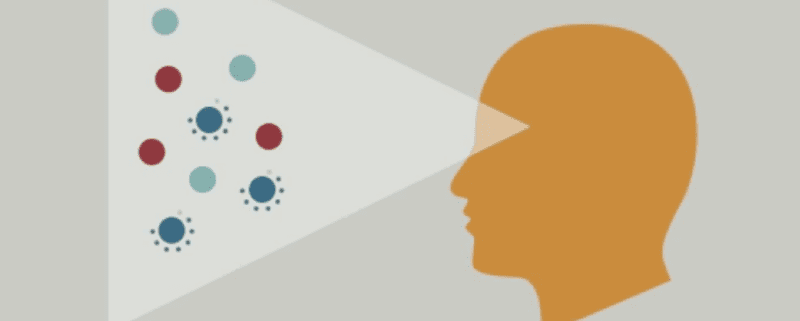Find your own Finland!
/1 CommentHaving just spent a few (extraordinary) days in Helsinki with the new Finland #NPDL Leads it became immediately obvious that there is a powerful education reform in motion there. The Finnish commitment to excellence, developing more that academic proficiencies is a clear reality, and a hot conversation topic, globally.
Working with the Leads made it immediately clear that the NPDL tools and processes have the potential to add the “How” to the “Why” and the “What” of edu reform.
As Michael Fullan speaks to us through the blog linked below, simply transplanting any model of education shift is prone to contextual and nuanced challenges, So, acknowledging and recognising our Finnish colleagues work, aspirations, standards, achievements and drive; take heart, ideas and inspirations; seek and find your own Finland!
Michael’s blog post
Education Development Trust Global Dialogue.
/1 CommentOn 1 November at 9pm UK time, 5pm Canada time and on 2 November at 8am in Australia and 10am in New Zealand an invited audience of school leaders will again be connecting together across continents in our second live Global Dialogue event.
Global Dialogue brings together schools who are collaborating together to bring about truly school-led improvement programmes. In this event, the schools share what works for them in their local context with others from diverse communities across three continents. Their commentary will be facilitated by leading educationalists Michael Fullan, Tony McKay, John Hattie, Vivianne Robinson and Steve Munby.
After the event, a recording will be available to view on this page:
This event will focus on some of the key themes that emerged from the last event, including:
Outcomes focused collaboration
Leadership capability for a network system
The power and potential of middle leaders
We are also privileged to hear from practitioners working in schools, in the UK, Canada, Australia and New Zealand who will join the event and will reflect on these themes and their own experiences of working in collaboration and will respond to the dialogue as it unfolds.
Deeper Learning and Project Based work
/0 CommentsToday we share a piece from our colleagues in Washington State. The NWESD 189 District is beginning it’s journey implementing NPDL, and it’s great to read their reflections and connections between existing and next practice.
The article below is reposted with permission from https://www.nwesd.org/edtalks/blog/deeper-learning

Did you know that currently one-third of American workers are engaged in some kind of freelance or project-based work? And because the internet can reach much larger audiences than ever before, almost anyone can download an app and start a business (examples:
The Deeper Learning initiative at NWESD is helping districts look at new pedagogical practices that are a combination of (1) a deeper understanding of core academic content, (2) the ability to transfer that understanding to novel problems and situations, and (3) the development of core competencies that prepare each student to be a transforming influence in the world.
These core competencies include critical thinking, communication, collaboration, creativity, citizenship, and character traits such as persistence and grit. Michael Fullan (2014) defines the ‘new pedagogies’ not just as instructional strategies, but as powerful models of teaching and learning, enabled by digital tools and resources, taking place in learning environments that support deep learning throughout the entire education system.
One pedagogical approach to Deeper Learning is project based learning. Some districts have adopted the concept-based curriculum design as their pedagogical approach. (offered at NWESD October 24-25), while other districts are incorporating problem-based curriculum design. (offered at NWESD on November 14-15). This article, “Preparing Students for A Project-Based World”, describes why and how all students would benefit from project-based learning and how you can get started.
Ed
Preparing Students for a Project-Based World http://gettingsmart.com/publication/preparing-students-project-based-world/
Fullan, M. & Langworthy, M. (2014) A Rich Seam: How New Pedagogies Find Deep Learning, London: Pearson.
Learning Momentum
/0 CommentsToday we continue to feature contributors from our global partnership.
 Patrick Miller is the Principal of Innovation with the Simcoe County District School Board in Ontario, Canada. He leads a team of Program and Innovation Instructional Resource Teachers who support innovative learning and teaching strategies across the district K-12. He works to connect learners to each other and to education thinkers around the globe. Patrick also serves as a support to the Canadian Cluster of New Pedagogies for Deep Learning. You can connect with Pat on twitter via @millerpEDU
Patrick Miller is the Principal of Innovation with the Simcoe County District School Board in Ontario, Canada. He leads a team of Program and Innovation Instructional Resource Teachers who support innovative learning and teaching strategies across the district K-12. He works to connect learners to each other and to education thinkers around the globe. Patrick also serves as a support to the Canadian Cluster of New Pedagogies for Deep Learning. You can connect with Pat on twitter via @millerpEDU
Pat shares his thoughts about engagement, empowerment and life long learning.
I was speaking to a group of teacher candidates recently, and asked them to finish the sentence,  “I want the students in my class to be…”. I captured their responses in this word cloud. No surprise that engaged was by far the most popular answer (as well as one person who just wanted them to be alive).
“I want the students in my class to be…”. I captured their responses in this word cloud. No surprise that engaged was by far the most popular answer (as well as one person who just wanted them to be alive).
Generally, people agree that it is a good thing that students are engaged while they are with us. But not every busy student or quiet class is engaged. Sometimes, engagement is just compliance with a smile. When we talk about engagement, we are often describing students thinking about and acting upon our ideas, our curriculum, our world. In that sense, engagement isn’t good enough! When pressed for what is it that is more impactful than engagement, we usually come to empowerment. Empowerment happens when students think about and act upon their ideas, their interests, their world.
 However, empowerment, like so many things, is determined by the receiver, not the giver. You may think you have empowered students, but if they don’t feel it, then they aren’t really empowered. I wrote a post about this called Staff Empowerment and Other Superpowers where I talked about staff empowerment, but I believe the statement below holds true for student empowerment as well.
However, empowerment, like so many things, is determined by the receiver, not the giver. You may think you have empowered students, but if they don’t feel it, then they aren’t really empowered. I wrote a post about this called Staff Empowerment and Other Superpowers where I talked about staff empowerment, but I believe the statement below holds true for student empowerment as well.
“Not only do you need to set the conditions and culture for empowerment, you also need to help them believe they are empowered. It doesn’t work if you don’t have both. A staff whose leader would gladly have them demonstrate initiative but never communicates that to them is left disenfranchised. A staff who believe they are empowered but don’t have any real self-determination is delusional.”
Empowerment requires genuine learning partnerships between and among students, staff and the wider school community. These partnerships enable and support all the benefits of co-authoring of the pedagogical practices, co-construction of the learning environment and co-curating of the digital tools which can accelerate student learning and make student thinking visible. While co-ownership of the learning is the goal, it should be made clear that real learner agency comes with all the perks and responsibility of ownership. Learners are responsible to their peers, staff, community and most importantly, themselves to be motivated, autonomous learners and contributing global citizens.
We have our students for a relatively short time in their overall life. What happens when they leave us? There is a long and hallowed tradition of wanting to prepare our students for the future and to impart the “truth”. The trouble is that in 5 years, 2 years or even next month, that truth and its context may have changed and these young people will not be equipped to discover the new truth.  While we can’t fully prepare our students for some unknown future or impart an unchanging and definitive truth, we can set in motion a life of learning. Our role is to generate learning momentum so when students leave our classrooms at the end of the day, our schools at the end of the year, and districts at the end of grade 12, they carry on learning.
While we can’t fully prepare our students for some unknown future or impart an unchanging and definitive truth, we can set in motion a life of learning. Our role is to generate learning momentum so when students leave our classrooms at the end of the day, our schools at the end of the year, and districts at the end of grade 12, they carry on learning.
We all need that learning momentum. As educators, the learning never stops. To me, best practices suggests an end point. We need to be sure to stop and celebrate these practices and success or people will complain that you keep moving the bar. But then, we must press on. When people say “We just learned that, now you want us to learn this? Make up your mind.” I think, “This is our best new thinking. How can you learn something new about your practice and not use it? This video, Better Starts Now is a great example of what we could miss out on if people see best practice or success as an end and not a beginning of something better. We keep iterating – not because we are not good enough, but because we can be even better. Who doesn’t want to be better for our students?
One of my favorite interview questions is “What is your best new learning?” You get a good sense of the candidate as a learner from how they respond. If you ever get asked that question, please don’t start your response with, “Last year I attended a …”
Where are the Learners?
/0 Comments
As we welcome back many teachers and learners from northern hemisphere summer vacation, we would also like to feature some thoughts from Cecilia de la Paz. Cecilia was Cluster Lead in Uruguay, and now works from New Zealand as a member of the NPDL Capacity Building Team.
Reflecting on the passing of Seymour Papert in July, Cecila challenges us to connect, engage and ignite learners and learning…….
Where are the Learners? Honoring Seymour Papert 1928-2016
I have been visiting schools, reading, thinking and co-creating with teams from different parts of the globe, aiming to find new or more effective ways to engage children in learning. As years go by I am more convinced that what professor Seyomur Papert stated is true ¨the best learning takes place when the learners take charge¨.
As early as 1968, Papert introduced the idea that computer programming and debugging could provide children a way to think about their own thinking and learn about their own learning. In 2016 we are still asking questions about the role of technology in our schools: looking for answers about the relationship between the learning, the learner and the digital tools. Papert´s vision in the 70´s was to see the computer as a space where different worlds co-existed, labs where children could experience, get it wrong, test boundaries and learn from their mistakes. 
But the learning experience must go beyond the tool. The learning experience may be inspired by technology, but needs be more complex and trigger an emotional connection between learning and learner – in the way we see education and gamification. Sad for recent Papert´s lost, I started to think what are the essential elements that combined surpasses systems, standards, curriculum and/or environmental conditions to inspire learners. What is the underlying essence that makes or could make teachers around the world, the ones that could successfully inspire a new generation to connect with themselves and the world in an exciting revealing way?
And it is true that ¨you cannot think about thinking, without thinking about thinking about something¨ as Papert stated. Maybe Andrea Schleicher could add ¨It is not about knowing everything but thinking as a mathematician¨ and that was precisely what Seymour shared with the world, a tool where you could just do that, unleash the thinking, igniting their inner fire.
Where everybody saw computers as big calculators, he saw beyond, and called them ¨the machine of the children¨ working to provide a tool that could convey his vision to give children more freedom and trust to learn. So what are the elements we are seeing today at school that could be changed, twisted, merged to other things to ignite the learner´s inner emotional connection with learning so it transforms them as human beings?
As G.Frasca reflected on Papert´s legacy…
¨we remember Prometheus for stealing from the Gods and distribute among men. But we hardly have examples of people that steal from the adults´ world, to give so generously to the children¨.
Let´s do that.
Seeing Dots!
/3 CommentsInnovation – no doubt it’s a buzz word.
Indeed, “Innovate or Perish” seems to be a common mantra across many layers of the world of work.
But what might it actually mean, for us in our work in the NPDL Partnership?
One of our four core elements are “New Pedagogical Practices”, aspects of teaching and learning that are (often) enabled, accelerated or amplified by the digital. Whilst there are true opportunities to innovate and extend our teaching and learning here, the notion of building on, or extending current practice through leveraging digital can be one of iteration as opposed to innovation.
So, shifting focus, I would like to share some thinking around the connection between learning partnerships and innovation. It is inspired by a video I came across in that “down-the-rabbit-hole” kind of search that sometimes occurs when you are not really sure what you are looking for, but hope it’s out there!
What messages do you hear in that video?
I was struck by the idea of “Innovation” being the dots and connections that others have missed, or forgotten!
I wonder, as we partner to build Critical Thinking and Creativity (and the other C’s) in our learners, whether we encourage, explicitly structure for and create opportunities for divergent thinking?
In terms of Learning Partnerships, do we make time to leave the “Sage on the Stage” role and allow learners to direct the conversations, the learning; opportunities to see dots that we perhaps do not?
As I write I am reminded of one of my all-time favourite videos – Steven Johnson’s “Where good ideas come from”. Steven talks about the collision of slow hunches, and about making space for this to happen.
In a classroom, these metaphors around collaborative creativity, and seeing new dots, underpin the whole idea of learners building new knowledge, and acting upon it.
So my search for more clarity around innovation has me, I think, seeing more dots – and I’ll leave you with more questions than answers!
Where is YOUR white space for innovation?
In your classroom, how are notions, unexpected connections, ideas, possibilities and imagination encouraged, in every learner, every day?
As always, please feel free to share your thoughts here on NPDLConnect, or through social media (@NewPedagogies | Facebook) or via email.
In depth,
@maxdrummy






